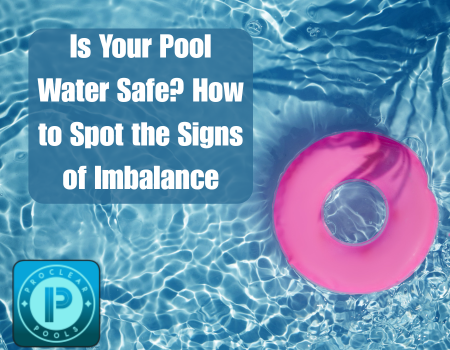Crystal-clear pool water isn’t just pleasing to the eye—it’s also a sign that the water is safe for swimming. But just because your pool looks clean doesn’t always mean it’s chemically balanced. Imbalanced pool water can lead to a host of problems, from irritated skin and eyes to costly equipment damage and bacteria growth. Knowing how to spot the early warning signs of an imbalance can help you take action before small issues turn into big headaches.
Here’s how to tell if your pool water is out of balance—and what you can do about it.
 1. Cloudy or Murky Water
1. Cloudy or Murky Water
If your pool water looks cloudy or hazy instead of sparkling clear, that’s a red flag. Cloudy water is often caused by improper chlorine levels, high pH, poor filtration, or excess debris and particles in the water.
What to do:
Test your water immediately. Check chlorine, pH, and calcium hardness levels. Clean your filter, brush down the pool walls, and consider a pool shock treatment to clear out contaminants and reset sanitizer levels.
2. Strong Chlorine Smell
Many people think that the stronger the chlorine smell, the cleaner the pool—but the opposite is often true. That harsh odor is typically caused by chloramines, which form when chlorine binds with sweat, oils, and other contaminants. This means the chlorine isn’t doing its job effectively.
What to do:
Shock the pool to break down the chloramines and free up chlorine to sanitize properly. Regular cleaning and encouraging swimmers to shower before entering the pool can also help prevent this issue.
3. Skin, Eye, or Throat Irritation
If you or your guests leave the pool with red eyes, itchy skin, or a sore throat, your water chemistry might be off. High or low pH levels, imbalanced chlorine, or poor water quality can all contribute to irritation.
What to do:
Use a test kit to check the pH and sanitizer levels.The optimal pH level for pool water falls between 7.2 and 7.6. If levels are outside this range, use the appropriate pool chemicals to restore balance.
4. Algae Growth
Algae is a clear sign that your pool water isn’t properly sanitized. If you notice green, yellow, or black patches on the pool walls, steps, or floor, it’s time to act fast. Algae can quickly take over a pool and make it unsafe for swimming.
What to do:
Shock your pool with chlorine, brush down the affected areas, and run your pump continuously until the algae is gone. Keep your chlorine levels consistent to prevent regrowth.
5. Foamy or Oily Water
If your pool water looks foamy or has an oily film on the surface, it could be due to residue from sunscreen, lotions, hair products, or the use of certain algaecides. This buildup can throw off water chemistry and clog your filtration system.
What to do:
Use a pool enzyme product to break down oils and organic materials. Regular skimming and weekly maintenance can help prevent this issue. Also, encourage swimmers to rinse off before getting in the water.
6. Corroded Metal or Scaling
Corrosion on ladders, railings, or pool equipment—or white, chalky buildup on tiles—is often a sign of low pH or high calcium levels. Both can damage your pool and shorten the lifespan of equipment.
What to do:
Test your pool’s pH and calcium hardness. Adjust levels as needed to stay within safe ranges and prevent damage. Keeping pH balanced also helps prevent staining and scaling.
Safe pool water is more than just clear—it’s a carefully balanced mix of chemicals that work together to keep swimmers healthy and your equipment in good condition. Investing a little time now can save you from major problems later—and ensure your backyard stays the refreshing oasis you want it to be.
